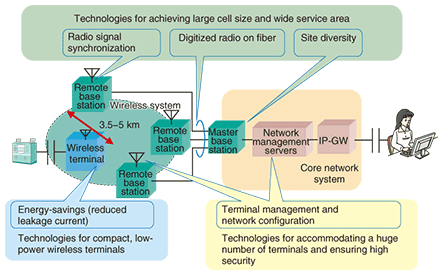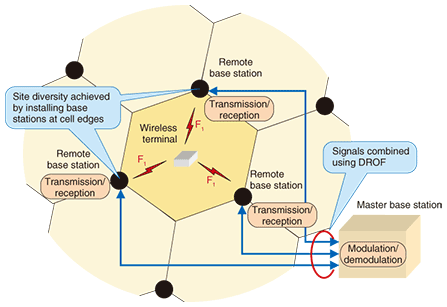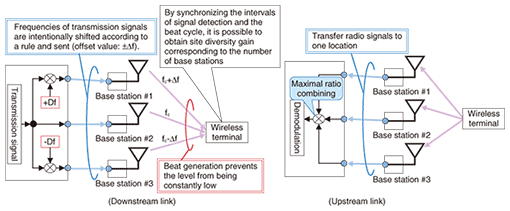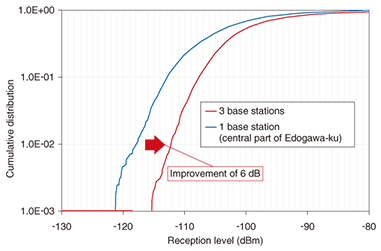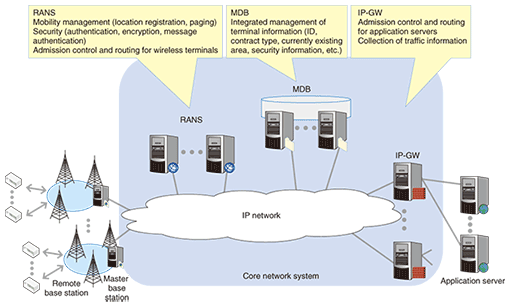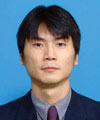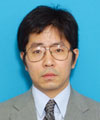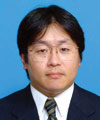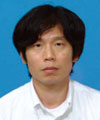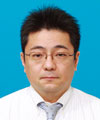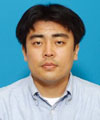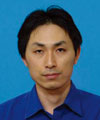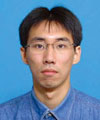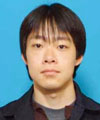 |
|||||||||||||
|
|
|||||||||||||
|
Special Feature: R&D of Wide-area Ubiquitous Network to Create New Services Vol. 8, No. 6, pp. 7–13, June 2010. https://doi.org/10.53829/ntr201006sf2 Technical Development Activities for Wide-area Ubiquitous NetworkAbstractThis article describes the main technologies that underlie the wide-area ubiquitous network, which we expect will create a new industry.
1. IntroductionThe wide-area ubiquitous network (WAUN) is characterized by the use of compact, long-life battery-driven wireless terminals, services that are less expensive than existing public wireless services, high security for customer information, and both indoor and outdoor service availability. It is a communication infrastructure that can provide bidirectional network services for collecting data from objects and delivering data to them [1]. The system configuration is shown in Fig. 1. This system is made up of a wireless system and a core network system. The wireless system consists of wireless terminals and base stations (remote base stations and master base station). The core network system consists of network management servers and internet protocol gateways (IP-GWs). A network management server authenticates wireless terminals and manages terminal identities (IDs) and locations. An IP-GW handles admission control for data transfer between the IP-GW and application servers. The wireless terminals have limited functionality to reduce their cost and to save energy; their functionality is supplemented by the functionalities residing in the rest of the network.
The main technologies we have developed for the WAUN are described below. 2. Wireless system technologiesWe have developed several technologies to enable the wireless system to offer a large cell size and cover wide service areas using compact low-power wireless terminals: site diversity allows each terminal to be served by multiple base stations, digitized radio on fiber (DROF) synchronizes the time of base stations and collects/delivers radio signals to support site diversity, and energy-saving technology enables compact low-power-consumption wireless terminals. These technologies have allowed the transmission power of wireless terminals to be reduced to 10 mW, which enables the system to satisfy two conflicting demands: allowing the cell radius to be as large as 3.5 to 5 km (wide area coverage) with wireless terminals powered by coin batteries that can operate for more than five years (energy saving). 2.1 Site diversityIn the traditional wireless system, some locations within a cell may not receive sufficiently strong radio signals from the base station. Therefore, to achieve a large cell radius in inter-object communication, it is necessary to overcome two major problems. (i) Unlike humans, objects cannot move autonomously to a location where they can receive a strong radio signal. (ii) The strength of the signal transmitted by a simple wireless terminal is so limited that the area that can be covered by the signal depends strongly on the surrounding circumstances. In particular, in urban areas, it is necessary to suppress shadowing loss and other forms of degradation caused by the shielding effects of high-rise buildings. To solve these problems and achieve a large cell radius, we have chosen to use site diversity. The way this is implemented in our network is shown in Fig. 2 and an overview of the developed site diversity technology is shown in Fig. 3.
Unlike the cell configuration of a mobile phone network, in which a base station is normally installed at the center of a cell (cell center configuration), in the WAUN, a cell is made up of multiple base stations, which are installed at cell edges (site diversity configuration). The directivity of the base station antennas is directed towards the center of each cell. This configuration’s technologies and advantages are described below. 2.1.1 Downstream linkThe conventional application of site diversity to downstream signals from a base station has some problems. First, the effect of site diversity is not as great as would be expected from the number of base stations. Second, the demodulation performed by wireless terminals becomes more complex as the number of base stations increases. We have solved these problems in the following manner. The frequency of transmission signals from each base station is intentionally shifted from those of other base stations according to a certain rule, and terminals demodulate signals according to the same rule. This makes it possible to increase the effect of site diversity as the number of base stations is increased while the complexity of the demodulation performed by each terminal remains unchanged [2]. This allows simple terminals to benefit from site diversity without any constraints on the number of base stations, so the signals from base stations can reach a large number of terminals. 2.1.2 Upstream linkConventionally, each base station demodulates upstream signals from terminals independently. Therefore, in the conventional application of site diversity to these upstream signals, individual base stations cannot cover dead spots. To solve this problem, signals from different base stations are gathered at one location and combined by applying maximal ratio combining (common-mode synthesis of signals after they have been weighted according to the signal reception level). They are then demodulated. This concerted operation of base stations makes it possible to cover the dead spots of individual base stations. This technology maximizes the effectiveness of the base stations in a site diversity configuration and enables base stations to cover more terminals even when their transmission power is low. 2.2 Digitized radio on fiberIn site diversity, one effective approach is to install base stations away from each other so that multiple propagation routes can be established. Since these base stations need to transmit or receive the same radio signal simultaneously, their timing must be synchronized precisely. For the WAUN, we developed DROF to achieve the required time synchronization. The base station functions are divided into multiple wireless transmission/reception parts (performed by remote base stations) and a wireless modulation/demodulation part (performed by the master base station), and these are connected to each other by DROF [3]. Since DROF allows remote base stations to be installed anywhere, it is possible to install remote base stations at the cell edges to achieve an effective site diversity configuration. The distribution of outdoor reception levels within a cell is shown in Fig. 4 for two cases: three base stations (site diversity configuration) and only one base station (cell center configuration). It shows the distribution of average reception levels within a 400-m2 area (20 m × 20 m). The reception level of the site diversity configuration is 6 dB higher than that of the cell center configuration at the point where the cumulative distribution is 1%. This effect is equivalent to increasing the cell radius by about 1.5 times.
2.3 Energy-saving technologyIn the inter-object communication services supported by the WAUN, applications are expected to communicate only infrequently. In a remote meter reading application, for example, a meter will be read only a few times a month. In an environmental sensing application, data will be sent roughly once an hour. In other words, the communication interval will be extremely long. In addition, terminals remain inactive most of the time. For such a terminal, in terms of its overall energy consumption, the standby energy consumed while it is inactive is more significant than the energy consumed during communication. We have chosen a multithreshold CMOS (complementary metal oxide semiconductor) circuit technology to greatly minimize the leakage power in standby mode. It suppresses the terminal’s overall energy consumption to a few microwatts in standby mode. This suppression technology enables an intermittently operating terminal powered by a coin battery to have a battery lifetime of more than five years. 3. Core network system technologiesThe core network system of the WAUN supplements the functions of the low-performance terminals. We have developed two technologies that make the core network system secure and scalable: terminal management technology achieves high security by managing a variety of terminal information within a limited wireless bandwidth and network configuration technology offers high scalability by using distributed processing of network functions for a large number of wireless terminals. (1) Terminal management technology When mobile terminals are connected to a wireless network and provided with communication services, they should be authenticated and their locations should be managed. We have developed an authentication and mobility management protocol for the WAUN. This protocol minimizes bandwidth consumption and the amount of computation so that it is applicable to narrowband wireless links and low-performance terminals. To ensure high security, we use authentication to prevent spoofing, encryption to prevent sniffing, and message authentication to prevent data alteration [3]. In the message exchange between wireless terminals and the core network system, we have reduced bandwidth consumption and the amount of computation by utilizing hash functions and wireless parameters for these security processes. To ensure efficient utilization of narrowband wireless links, a short identifier that is unique in each cell area is used to identify terminals in a wireless link instead of a long global identifier. These technologies provide authentication and mobility management of low-performance terminals. The security level is equivalent to those of other wireless systems. (2) Network configuration technology Since the WAUN requires authentication, location management, and data transfer to/from a huge number of terminals, it is necessary to use distributed processing on multiple servers to handle the enormous amount of processing. Although the WAUN supports a huge number of terminals, each one imposes a small load because the communication volume and frequency is very small, in contrast to conventional mobile networks. To reduce the overhead for the transfer of individual small items of data, the information obtained from mobility management is used as control information. This reduces the communication overhead for transferring control information. The configuration of the core network system is shown in Fig. 5. We have divided the functionality of the core network system into the radio access network server (RANS), IP-GW, and management database (MDB). RANS performs terminal authentication and mobility management, IP-GW is a gateway to and from the Internet, and MDB manages terminal information. In addition to this functional distribution, RANSs are distributed geographically in accordance with the locations of paging areas, and IP-GWs are distributed in accordance with the volume of traffic from application servers. With this configuration, the network offers high scalability and flexibility against changes in the number of connected terminals [5].
4. Main specifications of WAUNThe main specifications of the WAUN are listed in Table 1.
4.1 Frequency band usedFrom the macroscopic viewpoint of ensuring that radio signals cover as many wireless terminals as possible, it is advantageous to use relatively low frequencies because this reduces the radio propagation loss. On the other hand, to cope with microscopic changes in the radio signal strength caused by reflected waves (fading), an effect that all wireless systems are subject to, it is necessary to use space diversity, in which each base station uses multiple antennas. If the spacing between antennas is fixed, space diversity is more effective when the frequency is higher. Considering this tradeoff regarding the frequency level, we expect that a frequency within the VHF/UHF band (200–500 MHz) will be used. 4.2 Modulation methodTo achieve a large cell size, accommodate many terminals, and meet the low terminal power requirements, we have chosen π/4-shift quadrature phase-shift keying (QPSK) for both its modulation/demodulation characteristics and high efficiency in frequency and power resource utilization. 4.3 Transmission speedSince machine-to-machine (M2M) communication is characterized by a low data transfer volume and infrequent communication, it does not require as high a transmission speed as wireless local area networks and mobile telephone systems. We expect that the transmission speed will be around 9.6 kbit/s, which is equivalent to that of low-speed wireless systems, such as radio-frequency identification (RFID) systems. 4.4 Cell radius and terminal transmission powerFor the network to cover large geographical areas economically, it is necessary to use macro-cells, which have a cell radius of the order of several kilometers. Since we expect the transmission power of a battery-powered terminal to be around 10 mW, we have chosen a cell radius of 3.5–5 km. 5. ConclusionAs the WAUN becomes more widely used, it will become possible to collect and accumulate information from a wider variety of objects. We will continue with the development of technologies, such as data processing technology, that take full advantage of such information and contribute to enhancing the safety and security of communication and environmental friendliness. References
|
|||||||||||||








